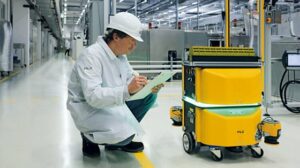More and more companies are using robots to assist their employees with physically demanding tasks. Automated Guided Vehicles (AGVs) are a popular application for transport solutions. However, the successful use of AGVs requires careful attention to safety aspects. Rocking Robots discussed this topic with safety advisor Barney Bartelink from Pilz Netherlands.
The formal definition of an AGV is a motorized vehicle, including any trailers, designed to drive automatically, and whose safe operation does not depend on a driver. Various types are possible, from trains that follow a track to autonomously driving robot carts. Typically, the AGV follows a fixed route, while the more advanced Autonomous Mobile Robot (AMR) follows flexible routes.
E-commerce, in particular, is a growth market for AGVs, where order picking in warehouses was traditionally done by people walking past racks to grab requested items. By robotizing with AGVs, this work can continue uninterrupted, often faster and more dynamically. Pallet AGVs provide transportation of heavy loads, alleviating the physical burden on employees.
System
Despite the autonomous nature of AGVs, safety does not come automatically. End users and integrators often consult the safety experts at Pilz. “We are often called in to conduct a risk analysis of the AGV implementation,” says Barney Bartelink, Safety Consultant at Pilz Netherlands. “An AGV may have a CE certificate, but the entire system must be certified, not just the individual machines.”
In a typical risk analysis, Bartelink and his colleagues examine factors such as driving routes, the space between driving paths and stables, the robot’s speeds, the load it carries, and its stability. “Bottlenecks include transition points where the AGV must turn off its sensors to transfer a load to a conveyor or another robot. These are the dangerous points. We scrutinize safety at these interfaces.”
Zones
Bartelink observes that organizations deploying AGVs often focus heavily on the capabilities of individual AGVs, such as their ability to avoid collisions with people. “However, the complete system receives less attention. To improve safety, users should consider dividing the system into zones. In an operating zone, only people walk. In a hazard zone, people walk in combination with AGVs performing dangerous actions, such as transferring a load. There are also zones with restrictions where people are not allowed to enter, and the speed can be much higher. It is crucial to define this well.”
People themselves can also be a risk factor. “It often happens that the limits for loads and sizes that AGVs carry are exceeded. If something is longer or higher than permitted, dangerous situations can arise because driving paths become too narrow or stability is compromised. Everything may go well initially, but over time people push the limits: ‘These boxes are fine, so ten centimeters higher should also be possible.’”
Laws and Regulations
None of this is optional. European legislation is currently being developed to tighten the rules for AGV use. The current Machine Directive will soon be replaced by the Machine Regulation. The Machinery Directive did not separately list autonomous mobile machines, which fell under general machines. The Machine Regulation, on the other hand, contains important additional requirements for mobile autonomous machines, making the systems more complex.
“The systems currently in operation usually consist of AGVs working autonomously. They don’t ‘know’ about each other’s existence. The new Machine Regulation includes the obligation to have an overarching system that communicates with those AGVs and monitors their status.”
“In the event of danger, that overarching system must be able to stop an AGV or move it to a safe place, for example, if it overheats and starts smoking.” The new rules will apply to new installations or installations where significant changes occur.
Cybersecurity
Safety of AGVs is not just about physical safety. As software and networks play a greater role in these solutions, cybersecurity is also increasingly important. “Carefully examine your networks, especially how changes can be made from outside. This is a significant IT issue, where IT companies play a role that approaches this from a different perspective.”
“You can imagine that a manufacturer wants to make a change; you don’t want to make the change to the wrong customer. Such things now need to be monitored much better. Until now, the Machinery Directive was mainly intended to ensure the safety of people. The Machine Regulation also works the other way around: it aims to protect the machine from people who intend to break into it or make mistakes.”
AI
Increasingly, AI and machine learning enable robots to perform more complex tasks and respond more contextually and adaptively in dynamic environments. “Embedding AI in industrial machines brings new safety challenges. We need to ensure these systems make the right decisions under normal circumstances and continue to function safely under abnormal or unforeseen circumstances. It is therefore essential to continuously update risk analyses and safety assessments in response to ongoing developments in AI technology.”
He concludes: “Trends such as cobots, increasing mobility, sensor integration, and modularity, combined with new legislation and regulations, ensure that robotization is not only becoming more advanced but also more accessible and flexible across a wider range of industries. It’s an exciting time for everyone involved, both from a technology standpoint and from a safety and regulatory perspective.”




